MSI GX640: $1100 for a Speedy DX11 Laptop
by Jarred Walton on June 13, 2010 3:05 PM ESTMSI GX640 LCD: An Oldie but Goody (Mostly)
Flash back to a couple years ago and in place of the current 16:9 aspect ratio displays we had a lot of 16:10 panels. The better laptops came with either WUXGA or WSXGA+ displays, and while brightness levels were lower than the latest LED backlit panels in most cases, quality wasn't bad at all. The GX640 is sporting just such a panel, courtesy of Samsung's 154MT02-H01. We've lamented the decline in laptop LCD quality on many occasions, and the GX640 is a great argument for going back to some of the better panels of days gone by. That's not to say the LCD makers can't create good displays anymore; rather, they simply choose not to in order to reduce costs.

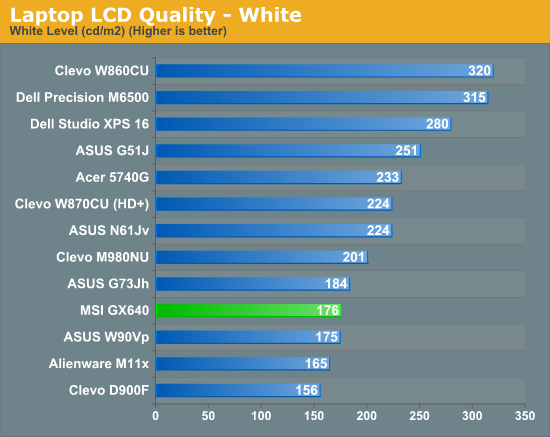
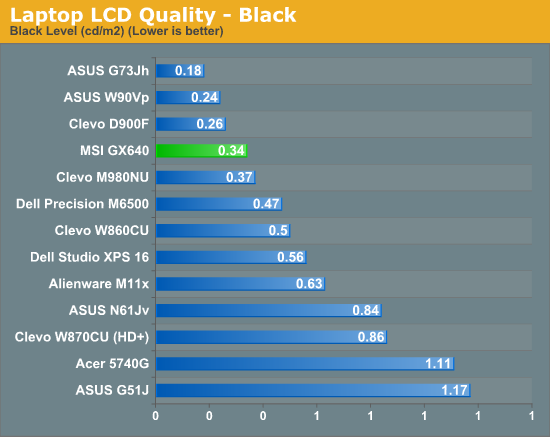
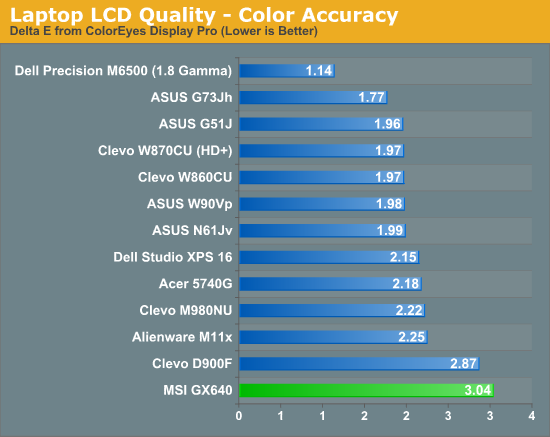
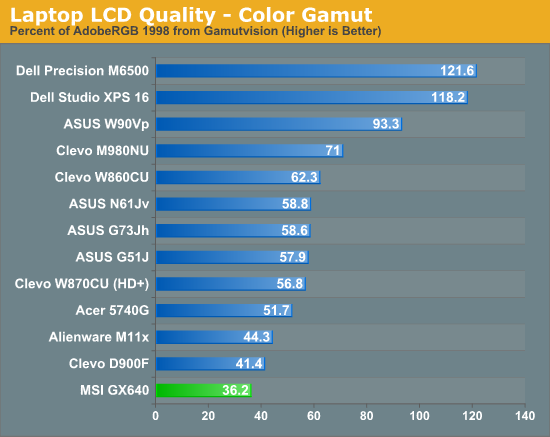
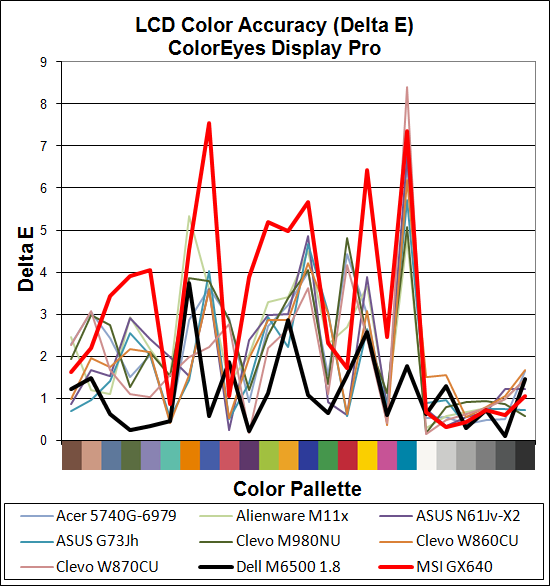
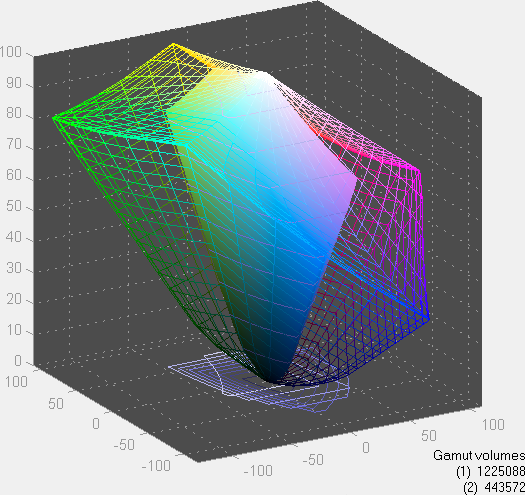
Color gamut and accuracy are nothing special and in fact the color gamut is at the bottom of our charts; the maximum white level isn't as bright as most modern laptops either. These metrics are where old CCFL panels fall behind. If you intend to use your laptop outside, the GX640 might not be the best choice. Inside under reasonable lighting is a different story, where the 517:1 contrast ratio looks great. The blacks in particular are far better than most midrange and entry-level laptops—the difference between a .34nit black level and the >1nit we see on so many laptops is painfully obvious if you know what you're looking for. So like we saw with the LCD in the W860CU, CCFL backlighting with better extinction levels can certainly compete with the latest LED backlit displays. Power draw may be a bit higher, but the HD 5850 already sucks down a fair amount of juice. What we'd really like is to see these good extinction levels on the blacks while providing the power and brightness characteristics of LED backlighting.
Viewing angles are typical of every TN-based laptop display that we've looked at, which is to say that they're okay horizontally but changes in vertical positioning can quickly cause dramatic shifts in colors and contrast. Set the GX640 on a table and load up a game and you probably won't notice any problems, but if you're looking at the display from a cramped airline seat you probably won't be able to get the best angle (or at least, I won't since I'm pretty tall—shorter users will probably be okay).















28 Comments
View All Comments
Ben.' - Sunday, June 13, 2010 - link
In your tests, you are saying you use a 5850 but in specs it says 5870?Ben.' - Sunday, June 13, 2010 - link
never mind"For games that support DirectX 11, we also tested it on the 5850 and will highlight those results (or 4xAA) in gold."
tipoo - Sunday, June 13, 2010 - link
I really wish you guys included Windows laptop graphs in the Macbook Pro reviews, and Macbook Pro graphcs in Windows laptop reviews.Flunk - Sunday, June 13, 2010 - link
There really wouldn't be much point in this particular case because Apple doesn't make a laptop designed for gaming. The best GPU you can get in a Macbook Pro is the Geforce 330M which is not even close to being competitive with the GPUs included in these benchmarks.tipoo - Sunday, June 13, 2010 - link
True, but at least for the battery life comparisons for the Macbook Pro review.JarredWalton - Monday, June 14, 2010 - link
The battery life tests that Anand runs on the MacBook aren't quite the same as the tests I run on Windows. I run Idle (best-case), Internet only (just browsing web with Flash, but no music playing), and x264 720p playback. Anand does a light Internet surfing test while looping MP3s in iTunes, a Flash Internet test (but using different web pages than my Windows test), Xvid playback (720p? I don't know), and a torture test with Xvid + iTunes + Internet.Since they're not using the same testing scenarios, I'm hesitant to compare the two directly. In general, MacBooks seem to have better battery life than similarly specced Windows laptops under similar loads. So CULV on Windows can last 10 hours on a 63Wh battery... and Mac does the same thing with a regular Core 2 Duo processor on a 63Wh battery. Or looked at another way, the ASUS U30Jc manages similar battery life to a typical 13" MacBook, but it does it with an 84Wh battery.
Penti - Thursday, December 16, 2010 - link
Bootcamp?rwei - Sunday, June 13, 2010 - link
This laptop reminds me pretty heavily one of the HP Envy series - you mentioned the 15 but there are now also 17 and (soon) 14 models.Having just ordered a 17 for ~$1200 after coupon, I'm surprised that one week after they began shipping (and days after people started receiving them), there still isn't a single review for it anywhere.
It might make for an interesting comparison. How much does $300 (base price) net you in build quality, screen, speakers, keyboard, etc?
NecessaryEvil-BC - Sunday, June 13, 2010 - link
You need to update your review to correct your mistake.Incidentally, MSI's GE-600 comes in at $200 less, drops the 5850 for a 5730, drops the aluminum for glossy plastic, drops the 15.4" 1680x1050 for a 16" 1366x768, but does gain switchable video. It's too bad this feature was omitted here.
JarredWalton - Sunday, June 13, 2010 - link
Odd... I tried to put a USB connector in there, and the specs do not indicate it's a combo port, as they only list "2 x USB": http://www.msimobile.com/level3_productpage.aspx?c...However, I tried again after your comment, and it turns out the eSATA port is just a *very* tight fit with USB devices. So the review is updated.
Note that the GE600 GPU is a substantial step down; the 5730 is only slightly faster than the 5650 in the 5740G (about a 20% increase in core clock -- 650 vs. 550 -- but with the same memory bandwidth). I didn't test the two laptops at the same resolution, since the 5740G is a 1366x768 panel, but it looks like half the performance at the same resolution is going to be pretty accurate. It has half the SPs (at about the same clock speed), and about one fourth the memory bandwidth.
As regarding switchable graphics, I glossed over the topic in the review, but there's plenty more to say. While it's good for battery life, there are a lot of complications on high-end laptops. First, if you have a laptop that you want to support quad-core i7, you can't do switchable unless you build in support for doing discrete *and* switchable in the same chassis. No one does that yet, as it's a big cost, so I understand the lack of switching graphics on the GX640. Optimus doesn't get around the requirement either because it has to transfer data over the bus to the IGP, so if there's no IGP present you're out of luck. I suppose what we need is quad-core mobile CPUs with an IGP, or else you have to decide to limit a laptop to only dual-core Arrandale CPUs.